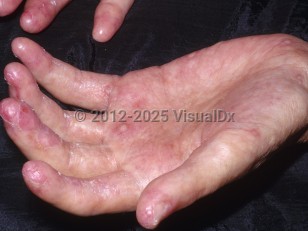The incidence of chronic GVHD is estimated to be 60%-70% in recipients of allogeneic (ie, genetically distinct donor) stem cell transplants with mismatched and unrelated donors. Incidence is approximately 30% in recipients of fully histocompatible sibling donor transplants. GVHD may also occur in solid organ transplant and blood transfusion recipients.
The risk of developing chronic GVHD increases with advancing age, prior history of acute GVHD, history of splenectomy, and donor or recipient cytomegalovirus seropositivity. GVHD can also be triggered by changes in immunosuppression, exposure to ultraviolet (UV) light, physical trauma, varicella-zoster virus, and Borrelia infection.
Activation of host antigen-presenting cells (APC) triggers a cytotoxic donor T-effector response. Thymic injury with subsequent autoreactive and alloreactive T-lymphocyte proliferation and a dysregulated TH17 response lead to macrophage and fibroblast activation with altered diffuse tissue repair and fibrosis.
Chronic GVHD most commonly affects the following organ systems:
- Skin (77%-100%): oral mucosa (16%-55%), ocular mucosa (12%-46%), and genital skin (2%)
- Lungs (11%-47%)
- Gastrointestinal (GI) tract (24%-47%)
- Liver (20%-38%)
- Peripheral nervous and musculoskeletal systems (0%-6%)



